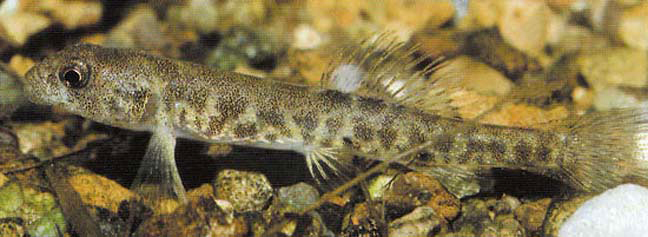- Classification
- ACTINOPTERYGII
- SALMONIFORMES
- GALAXIIDAE
- Paragalaxias
- eleotroides
Great Lake Galaxias, Paragalaxias eleotroides McDowall & Fulton 1978

Great Lake Galaxias, Paragalaxias eleotroides. Source: Gerald R. Allen. License: All rights reserved
A small stout galaxias found on in the Central Highlands of Tasmania. The Great Lake Galaxias is brownish-gold with irregular diffuse blotching and speckling on the back and sides, a silvery-green belly, and brownish-orange to olive fins with dark blotches along fin rays.
Great Lake Galaxias, Paragalaxias eleotroides McDowall & Fulton 1978
More Info
|
Distribution |
Endemic to the Tasmanian Central highlands and known only from Great Lake and Shannon Lagoon. The Great Lake Galaxias inhabits rocky areas, as well as algal and macrophyte beds around lake margins in shallow water to 10m. During floods the species is found in swampy areas close to rocks, woody debris and plant cover. Larvae are pelagic and juveniles greater than or equal to 30 mmTL live in the same habitats as the adults. |
|
Features |
Dorsal fin 13-16 (usually 14-15); Anal fin 7-9 (usually 8); Pectoral fin 13-14; Pelvic fin 5-6 (usually 6); Vertebrae 37-40. Body elongate, slender, trunk cylindrical in cross-section; belly flattened, back arched, head depressed; body compressed behind anus; caudal peduncle long and slender; snout profile moderately steep; mouth of moderate sized, slightly oblique, extending back to front of eyes; jaws about equal; lips fleshy; jaw teeth conical without enlarged canines laterally; lateral line present; open pores present on head, rows of laterosensory papillae on head and tail base; pyloric caecae absent. Dorsal fin long-based, moderately high, rounded, inserted behind midbody at about pelvic fin bases; pectoral fins large, inserted low lateroventrally; pelvic fins quite large, inserted behind mid-body; caudal fin truncate to emarginate, tips rounded; peduncle flanges weak. |
|
Size |
To 5.9 cm SL, commonly to 4 cm. |
|
Colour |
Overall golden-brown, head and upper body finely speckled with melanophores, sides with irregular brown blotches. |
|
Feeding |
Feeds on aquatic insects and insect larvae, planktonic crustaceans, eggs of other galaxiids and some algae. |
|
Biology |
The Great Lake Galaxias completes its entire life cycle in lake habitats. Individuals mature after one year, and the maximum life span is 2-3 years. Spawning occurs during spring, and females produce clusters of 44-149 light orange eggs that are about 2 mm in diameter. The eggs are guarded until the larvae hatch. |
|
Conservation |
|
|
Etymology |
Species name eleotroides is derived from the generic name Eleotris, in reference to the similarity in appearance and behaviour of this species and gudgeons of the family Eleotridae. |
|
Species Citation |
Paragalaxias eleotroides McDowall & Fulton 1978, Aust. J. Mar. Freshwat. Res. 29(1): 101 figs 5, 8. Type locality: Great Lake, Tasmania. |
|
Author |
Martin F. Gomon & Dianne J. Bray |
Great Lake Galaxias, Paragalaxias eleotroides McDowall & Fulton 1978
References
Allen, G.R. 1989. Freshwater Fishes of Australia. Neptune, New Jersey : T.F.H. Publications 240 pp., 63 pls.
Allen, G.R., Midgley, S.H. & Allen, M. 2002. Field Guide to the Freshwater Fishes of Australia. Perth : Western Australian Museum 394 pp.
Fulton, W. 1982. Observations on the ecology of four species of the genus Paragalaxias (Pisces: Galaxiidae) from Tasmania. Australian Journal of Marine and Freshwater Research 33: 999-1016.
Fulton, W. 1988. The freshwater fish fauna of Tasmania's western Central Plateau. pp. 1-23. Inland Fisheries Commission, Hobart.
Fulton, W. 1990. Tasmanian Freshwater Fishes: Fauna of Tasmania Handbook No. 7. University of Tasmania, Hobart, Tasmania.
Hardie, S.A., Macfarlane, K.R. & Barmuta, L.A. 2011. Life histories of galaxiid fishes in Arthurs Lake and Great Lake, Tasmania, and effects on water level fluctuations on their populations. Hydro Tasmania, Hobart. 200p.
McDowall, R.M. (ed.) 1980. Freshwater fishes of south-eastern Australia (New South Wales, Victoria and Tasmania. Terrey Hills, N.S.W.: Reed, 208p.
McDowall, R.M. 1998. Phylogenetic relationships and ecomorphological divergence in sympatric and allopatric species of Paragalaxias (Teleostei: Galaxiidae) in high elevation Tasmanian lakes. Environmental Biology of Fishes 53: 235-257.
McDowall, R.M. & Frankenberg, R.S. 1981. The galaxiid fishes of Australia. Records of the Australian Museum 33: 443-605.
McDowall, R.M. & Fulton, W. 1978. A revision of the genus Paragalaxias Scott (Salmoniformes : Galaxiidae). Aust. J. Mar. Freshwat. Res. 29(1): 93–108
McDowall, R.M. & Fulton, W. 1978. A further new species of Paragalaxias Scott (Salmoniformes : Galaxiidae), from Tasmania with a revised key to the species. Australian Journal of Marine and Freshwater Research 29(5): 659-665 figs 1-4
Merrick, J.R. & G.E. Schmida. 1984. Australian freshwater fishes: biology and management. Griffin Press Ltd., South Australia. 409 p.
Paxton, J.R., G.R. Allen, J.E. Gates, D.J. Bray & D.F. Hoese. 2006. Galaxiidae. pp. 402-411 in Beesley, P.L. & Wells, A. (eds). Zoological Catalogue of Australia. Volume 35 Australia : ABRS & CSIRO Publishing Parts 1-3, 2178 pp.
Paxton, J.R., D.F. Hoese, G.R. Allen & J.E. Hanley. 1989. Zoological Catalogue of Australia. Volume 7. Pisces. Petromyzontidae to Carangidae. Australian Government Publishing Service, Canberra. Zoological Catalogue of Australia. Volume 7. v. 7: i-xii + 1-665.
Threatened Species Section. 2006. Recovery Plan: Tasmanian Galaxiidae 2006-2010. pp. 85. Department of Primary Industries and Water, Hobart, Tasmania.


